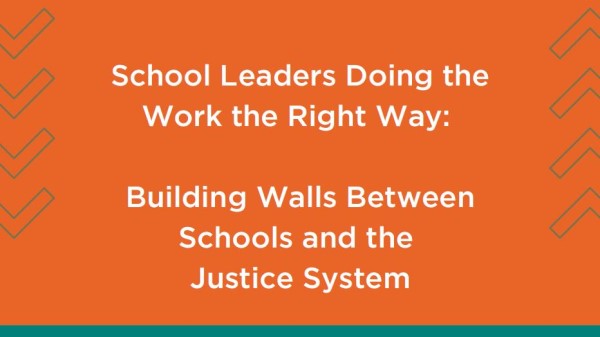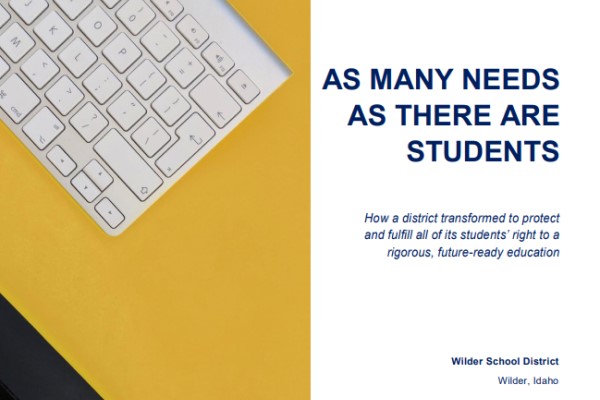How Schools Can Disrupt the School to Prison Pipeline
May 10, 2023
AASA profiled five school districts during the 2021-2022 school year that are building walls between schools and the justice system, engaging in restorative practices, working to eliminate bias and disproportionality, and providing all children with fair and equitable access to high-quality opportunities.

Districts profiled include:
- Aldine ISD, Houston, TX;
- Brownsville Area School District, PA;
- St. Louis Public Schools, MO;
- Phoenix Union High School District, AZ; and
- Riverhead Central School District, NY.
AASA sought districts that worked intentionally to reduced school-related juvenile justice interactions where the superintendent and school system played a key role in changes to limit youth interaction with law enforcement, school-based arrests, and juvenile justice. AASA created five district profiles and a summary profile of the districts’ work to reduce school - related juvenile justice interactions.
Profile Process
District profiles were created following a two-step interview process with districts.
The initial brief interview was typically with the superintendent and an assistant superintendent. This call was designed to provide districts with more information about the project and their participation. It was also an opportunity for AASA to ‘scratch the surface’ and learn more about what they were doing to create barriers between school and the justice system.
After the brief call, a longer (60 minutes) call was scheduled with the superintendent and district team charged with any aspect of this work. Team size varied according to the size of the district, but no one person was solely responsible for the work – it’s clear that it takes a committed team to make the kind of lasting changes to policies, practices, and culture in a district.
Getting to know more about the districts through the profile process challenged many beliefs about how districts manage their discipline procedures. For instance, St. Louis, a large, urban, predominantly Black district, does not have School Resource Officers (SROs). The district has its own police force instead of a contractual agreement with the city police department or another law enforcement authority. Following the death of George Floyd, Phoenix Union HSD, another large, urban district, chose not to renew their SRO contract, opting instead to enlist the community in creating solutions for school safety.
Challenges & Opportunities
Each district profiled noted the impact that Covid-19 had on their efforts. While time out of school due to the pandemic posed challenges for everyone, it also provided districts with opportunities to make bold moves, such as fully embracing Social, Emotional Learning (SEL) and enhancing mental health supports for students. The pandemic provided districts with new funding to enhance and create innovative programs to better support students upon return to in-person learning. Districts noted that efforts begun prior to Covid did suffer from the time away, but Aldine ISD saw a faster return to pre-Covid behaviors because of the changes they’d made prior to school shutdown.
Change doesn’t sit in any one department alone but is necessary across the district and at all levels.
Districts face complex challenges as they strive to end the school to prison pipeline. Riverhead Central School District on Long Island, NY, is charged with educating students from three police jurisdictions. This complicates matters when a student has been arrested because the district has to deal with the different policies and procedures of each jurisdiction. Additionally, there is a heavy police presence in the district as a New York State police barracks is located there as well. Students in Phoenix Union must follow the protocols set by the local police, but also follow strict state guidelines for certain juvenile offenses. Brownsville Area School District is very small with a local police force that’s active one day a week. The state police handle oftentimes step in to handle problems in the absence of local police. There is no ‘one-size fits all’ solution or blueprint for districts to follow when creating a plan to prevent student involvement with the justice system.
Creative Solutions
Each of the districts profiled share common characteristics including support from the school board, superintendent, and staff at all levels. Change doesn’t sit in any one department alone but is necessary across the district and at all levels. The work is data-driven as the data tells the story of the impact of disproportionality for Black and Brown students. Solutions are varied and creative as everything from an overhaul of the Code of Conduct to the elimination of SRO contracts can have a positive impact on students, keeping them out of the justice system and in school and learning, ultimately graduating ready for college, career, or military service.
Aldine ISD (Houston, Texas)
How one district lowered the number of disciplinary referrals with a focus on SEL, mental health and culture.
Brownsville Area School District (Penn.)
A look at one district's focus on restorative practices, which allow students to be connected to resources within the school while also having alternatives to the discipline practices.
St. Louis Public Schools (Mo.)
An update on policies to focus on restorative practices linked to infractions instead of suspensions.
Phoenix Union High School District (Ariz.)
A focus on a formal, structured reentry process and prioritizing early intervention.
Riverhead Central School District (N.Y.)
To combat the over-reliance on in- and out-of-school suspensions, the district moved to a restorative practice model that includes social workers and psychologists as part of the three-year implementation strategy.
This project was funded by the Annie E. Casey Foundation. We thank them for their support while acknowledging that the findings and conclusions presented in these profiles are those of the authors alone, and do not necessarily reflect the opinions of the Foundation.
Bridging Education and Justice: Transforming Schools and Communities
This webinar explores the consequences of punitive practices and highlights powerful strategies for creating a more equitable, inclusive, and nurturing educational environment.
Real Districts Affecting Real Change
Each of the districts profiled for this work share common characteristics, including support from the school board, superintendent and staff at all levels.
Change doesn’t sit in any one department alone but is necessary across the district and at all levels.
The work is data-driven as the data tells the story of the impact of disproportionality for Black and Brown students. Solutions are varied and creative, as everything from an overhaul of the code of conduct to the elimination of SRO contracts can have a positive impact on students, keeping them out of the justice system and in school, learning and ultimately graduating ready for college, career or military service.
Advertisement
Advertisement
Advertisement
Advertisement


-(9).png?sfvrsn=36febad1_7)
